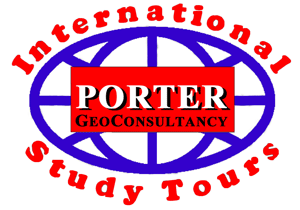| |||||||||||
| |||||||||||
| |||||||||||

By Mike Porter *
Though they were just a few degrees south of the equator, the group fastened their warm jackets against the chill breeze.
It blew down from the three glaciers perched above the cliffs of jagged, contorted limestone that form the face of Puncak Jaya, which at just over 5000 m, is the tallest mountain eastward from the Himalayas to the Andes. In its passage from the glaciers, the chill breeze crossed the vast stepped benches of the world's largest gold mine. The twelve geologists of the AMF Pacific Gold International Study Tour stood, and marvelled at both the majesty of this remote and forbidding location, and at the formidable engineering feat to develop and operate the immense open pit mine in these isolated mountains. They were here, at the Grasberg mine of PT Freeport Indonesia, in the Ertsberg District of Irian Jaya, as part of an advanced educational tour that would take them to nine great gold mines, from Lihir in eastern PNG, through Indonesia and the Philippines to Hishikari in Kyushu, Japan. These geologist had come from nine countries in Australasia, South-east Asia, North and South America, and Africa. They represented a selection of the world's greatest gold companies - companies who take the long term view to develop the staff that will help them maintain their leadership into the future. Today had been the culmination of two fabulous days at the Freeport operation - two days they would later unanimously agree had been the highlight of the whole tour. Some 48 hours before, the group had arrived at Timika, in the steamy tropical lowlands between the mountains and the Arafura Sea. They had flown in on the fast twin turbine charter aircraft that had taken them around Papua New Guinea visiting both the Lihir and Porgera gold mines over the previous three days. On that first night in Timika they were treated to a barbeque with the Freeport exploration staff and a comprehensive series of presentations on the regional and local setting of, and exploration in, the Ertsberg District, supported by extensive, pertinent hand-outs and guide books that they would use again over the following days. Next morning they departed at dawn and drove the 80 km laterally and 3 km vertically up the company road to the underground offices near the Amole Portal. There they were treated to an excellent briefing on the Ertsberg Skarns, before going underground to traverse through the giant Kucing Liar and Big Gossan gold-copper skarn orebodies. They spent the remainder of the afternoon studying core through these deposits on the surface. This was followed by dinner with the mine staff that night, at which members of the tour group exchanged presentations on their own gold deposits. The following day started with another early wakening after spending the night at the company town of Tembagapura. First a 10 km bus ride to catch the cable tram spanning the rise up the 700 m cliff from the mill to the Grasberg mine level. Then on by road to the top of the pit, at a height of over 4200 m above sea level. After on site briefings they were guided through the pit, observing all of the hosts, alteration and mineralisation types, as well as the wall rocks. This great porphyry and skarn complex, which produced 88 t (2.8 Moz) of gold in 1998, more than any other operation in the world, has remaining proven+probable reserves of 2.48 Gt @ 1.05 g/t Au and 1.13% Cu, for 2600 t (84 Moz) of contained gold. This superb two day visit to a set of incomparable ore deposits was a credit to the professionalism of Freeport Manager-Geology Al Edwards and all of his team, most of whom eagerly and expertly contributed. Now, nearing the end of the visit, the group stood and looked down under a bright cold sky, as the dense afternoon cloud began to well up from the deep valley below. It first engulfed the giant mill, over 1500 m lower, and then the upper station of the cable tramway capable of lifting 100 men per car up the cliff. After a final pause to soak up the view and to savour the moment, they left the sunshine and went down to that tramway station, down into the dense cloud, past the mill and the town of Tembagapura, to arrive at Timika in the late afternoon. Next day they would continue this unrivalled experience and fly on to Sulawesi, to commence the next phase of the tour. The Tour The group had first assembled in Port Moresby from around the world, arriving progressively from the afternoon of Saturday 11 to the morning of Sunday 12 September. After an introductory meeting, they set out for the airport at noon that Sunday and took off on the air charter by 1:00 pm. They first spiralled upwards to gain altitude and clear the cloud shrouded peaks of the Owen Stanley Ranges, then across the Solomon Sea to refuel at Hoskins on New Britain before continuing on to Lihir Island to the east, out in the Pacific. Monday was a fascinating and rewarding day spent at Lihir Gold's immense Lihir porphyry to epithermal low sulphidation gold mine, followed by the three hour flight back to Madang on the main island of New Guinea in the late afternoon and evening. Next morning was an early start to fly on to Porgera, arriving overhead by 8:00 am. Several layers of dense, shifting cloud in the valley which is bounded by jagged limestone peaks forced a diversion to Mendi and a 2 hour wait for the weather to clear. Never the less, they were safely on the ground in Porgera by 11:15 am. The remainder of that day, until dark, was spent in the office and open pit at Placer Dome's Porgera mine studying the large low sulphidation gold-silver deposit. They flew out of Porgera at dawn next day on a second, chartered aircraft, a Twin Otter capable of lifting the full group out from the short mountain airstrip and on to Mt Hagen where the larger faster plane was waiting. Upon clearing PNG Immigration, they flew south-west across the border to Merauke in Irian Jaya, Indonesia, for fuel and formalities, and then on to Timika. After the two Freeport visits to the Grasberg porphyry and Kucing Liar and Big Gossan skarn deposits of the Ertsberg District, several members of the group left the tour, to be replaced by new starters in Manado on Sulawesi. The flights from Timika to Manado were by commercial airliner, in two steps, with an overnight on Saturday in Ujung Pandang, the old city of Makassar, on the southern tip of Sulawesi, famous for its filigree gold craftsmen. After another dawn start, Monday was taken up by an exciting three hour drive from Manado, for a very professional and revealing visit to the sediment hosted Mesel Gold Mine of PT Newmont Minahasa Raya, followed by the return, arriving back after dark. The following days were spent travelling again, direct from Manado to Singapore, for an overnight, and then on to Manila in the Philippines. Thursday saw a further dawn departure, in two twin engine charter aircraft, flying north from Manila to the Mankayan District of central Luzon, landing through a fortuitous gap in the dense cloud piled up against the high cordillera by the tail of super-typhoon Bart, now heading north across the South China Sea. At Mankayan the group had the opportunity to study at first hand the complex of inter-related deposits that included going underground at the rich low sulphidation epithermal Victoria gold mine, inspecting core from the deep Far South-East porphyry opper-gold resource and poring over exposure in the high sulphidation Lepanto enargite copper-gold open pit. The complex is operated by the Lepanto Consolidated Mining Company. The group flew out in the late afternoon of the same day to arrive in Baguio City, where they spent the night. Next day was a field workshop hosted by Benguet Corporation. It involved an initial thorough presentation, followed by the rest of the day looking at both surface and open pit exposure of the ore and country rocks in and around the Antamok and Acupan deposits with a group of experienced local geologists. That night the group took the two charter aircraft back to Manila to spend the night, before flying to Kyushu in Japan by commercial airliner on Saturday, arriving in Fukuoka, via Osaka, in the early evening, again in the wake of typhoon Bart which by now was over Hokkaido. On arrival in Fukuoka they were met by Professor Sachihiro Taguchi of Fukuoka University and headed by charter bus to Kuju where they spent the night in a traditional Japanese country inn. Over the next three days Professor Taguchi, a renowned expert on modern hydrothermal systems, hosted a field workshop. They visited active volcanoes, hot spring fields, and geothermal power stations where gold is being precipitated at ore grades in a quartz-carbonate-smectite gangue within the pipes, replicating the formation of open space fill veins. Interspersed with the field workshop were visits to the bonanza vein, low sulphidation gold ores in the Hishikari mine of Sumitomo Metals, and Nippon Mining's high sulphidation Kasuga open gold pit. The Japanese leg was the perfect climax to the tour, placing into context all that had been learned over the preceding weeks, adding an extra dimension to the tour and answering many of the questions that had arisen along the way. Virtually all of the mine visits and workshops on the tour had been fabulous, and although the Freeport operations were voted the best, it was a very difficult choice. All of the tour group were deeply appreciative of the professionalism and cooperation of the geologists at these operations who contributed their time and experience to make the tour such a success, while it was a privilege to have travelled with and learned from Professor Taguchi. The tour ended in Kagoshima on the morning of Wednesday 29 September when the group dispersed like a starburst around the world - southward to Australia and south-east Asia, north across the pole to Europe, east to the Americas and west to Africa. A Joint Tour This very successful tour was a joint venture, conducted in cooperation with the Geological Society of South Africa, the Agencia para o Desenvolvimento Technologico da Industria Minera Brasileira (ADIMB of Brazil), and the Mineral Deposits Division of the Geological Association of Canada. The overall planning, organisation and management of the tour was undertaken by the AMF, while the other organisations promoted the tour to their memberships, who were in return granted the privilege of AMF Member rates. Members from all four organisations were represented on the tour, which was fully subscribed, with all available positions being filled on the sections of the tour that were run. The Series Continues This was the eighth such tour conducted by the AMF over the last three years. In all, these have visited almost 100 of the world's most important ore deposits, in North and South America, Africa, Europe, Asia and Australasia. These tours have been attended by geologists from all of the same continents and from most of the worlds most important mining and exploration companies. Four future tours are currently in various stages of development. These are:
PorterGeo Home | More on This Tour | Other Tours | About AMF | |||||||||||











